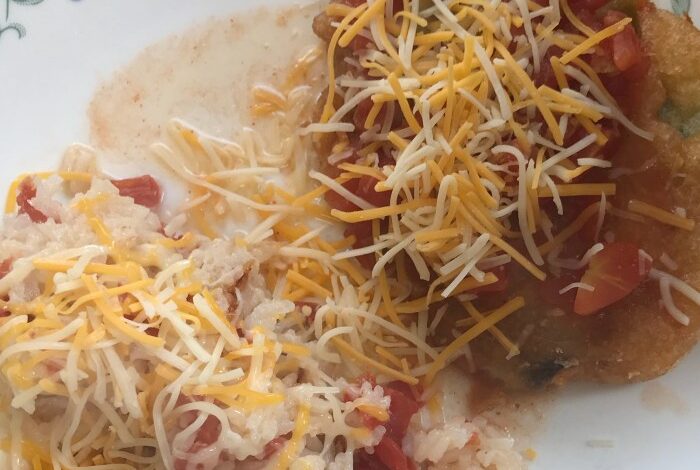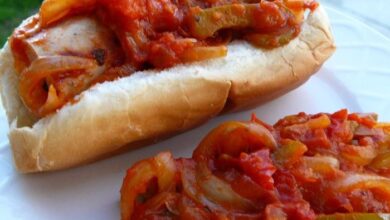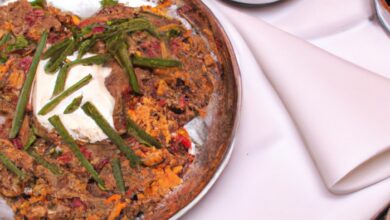
Authentic Mexican Chili Rellenos: A Culinary Journey
Authentic Mexican chili rellenos are more than just a dish; they’re a culinary journey through Mexico’s rich history and vibrant culture. From their humble origins to their present-day variations, these stuffed peppers tell a story of tradition, innovation, and the enduring power of flavor.
Imagine a dish that combines the smoky heat of roasted chiles with the creamy richness of cheese, all enveloped in a crispy, golden-brown crust. This is the essence of authentic Mexican chili rellenos, a dish that has captured hearts and stomachs for generations.
History and Origins: Authentic Mexican Chili Rellenos
Chili rellenos, a beloved Mexican dish, have a rich history deeply intertwined with the country’s culinary traditions. The origins of this dish can be traced back to the pre-Hispanic era, where the indigenous people of Mexico cultivated and consumed chiles.
Over time, the dish evolved and incorporated influences from the Spanish colonization, ultimately becoming the iconic Mexican comfort food we know today.
Authentic Mexican chili rellenos are a dish that always reminds me of warm summer nights and family gatherings. The creamy, cheesy filling and the slightly spicy peppers are a perfect combination. If you’re looking for a similarly comforting dish with a cheesy twist, you might enjoy this cheesy ham and asparagus bake.
Both dishes offer a satisfying blend of flavors and textures, perfect for sharing with loved ones. Just remember, nothing beats the authentic taste of chili rellenos made with fresh ingredients and a touch of love!
Evolution of the Dish
The earliest versions of chili rellenos likely involved stuffing chiles with simple fillings like corn, beans, or herbs. With the arrival of the Spanish, new ingredients and cooking techniques were introduced, including cheese, meat, and frying methods. This led to the development of more elaborate versions of chili rellenos, with fillings like ground beef, chorizo, and various cheeses becoming increasingly popular.
Regional Variations
Chili rellenos are enjoyed throughout Mexico, with each region adding its own unique twist to the dish. For example, in the state of Puebla, chili rellenos are typically stuffed with a mixture of ground beef, chorizo, and cheese, and then dipped in a batter made from eggs and flour before being fried.
In the state of Oaxaca, chili rellenos are often filled with a combination of cheese, mole sauce, and roasted tomatoes. These regional variations highlight the diversity and creativity of Mexican cuisine.
Cultural Significance
Chili rellenos hold a special place in Mexican culture and are often served during celebrations and special occasions. The dish is a symbol of Mexican hospitality and is often prepared for family gatherings and fiestas. Chili rellenos are also a popular street food in Mexico, and can be found in many markets and food stalls throughout the country.
Authentic Mexican chili rellenos are a labor of love, requiring careful attention to the chiles, the filling, and the batter. But the reward is a dish bursting with flavor and texture. Speaking of delicious combinations, have you tried making your own banana pudding?
There are some fantastic recipes out there, like the ones you’ll find on this website. And just like a perfectly crafted banana pudding, the secret to amazing chili rellenos lies in the balance of sweet and savory, creamy and crunchy.
Ingredients and Preparation
Preparing authentic Mexican chili rellenos involves a careful selection of ingredients and a methodical approach to preparation. From the chili peppers to the filling, each element contributes to the dish’s distinctive flavor and texture.
Chili Peppers
The heart of chili rellenos is the chili pepper. The most traditional choice is the poblano pepper, known for its mild heat and thick walls, which are perfect for stuffing. Here’s a step-by-step guide for preparing poblano peppers:
- Roasting:Poblano peppers are typically roasted over an open flame or under a broiler until the skin is blackened and blistered. This process not only softens the peppers but also imparts a smoky flavor.
- Peeling:Once roasted, the peppers are placed in a plastic bag and allowed to steam for about 10 minutes. This makes peeling off the blackened skin much easier.
- Seeding:After peeling, the peppers are sliced open lengthwise, and the seeds and ribs are removed. The ribs contain most of the heat, so removing them ensures a milder flavor.
Filling Options
The filling is the soul of the chili relleno. While cheese is the most common, there are many other delicious possibilities.
- Cheese:The most popular cheese filling is a blend of queso fresco and Monterey Jack, offering a creamy and slightly tangy flavor. Other cheeses, such as Oaxaca or Chihuahua, can also be used.
- Meat:For a heartier filling, ground beef or pork seasoned with spices like cumin, oregano, and chili powder is often used. This filling is often combined with onions and garlic for added flavor.
- Vegetable Combinations:A variety of vegetables, such as mushrooms, spinach, and bell peppers, can be incorporated into the filling for a vegetarian option.
Cooking Techniques
Cooking chili rellenos involves various techniques, each offering a distinct flavor profile and texture. From the classic frying method to the healthier baking and grilling options, these techniques cater to diverse culinary preferences and dietary needs.
Authentic Mexican chili rellenos are a dish that demands respect. The rich, savory flavors of the chile relleno itself are perfectly balanced by the creamy, tangy sauce. For a cool and refreshing finish to this hearty meal, I always recommend a scoop of sweet and silky strawberry sorbet.
The bright, fruity notes of the sorbet cut through the richness of the chili rellenos, creating a harmonious balance of flavors. After all, even the most passionate chili relleno enthusiast needs a little something sweet to end the meal on a high note.
Frying
Frying is the traditional method for cooking chili rellenos, resulting in a crispy exterior and a soft, flavorful interior. This technique involves immersing the filled peppers in hot oil, ensuring even cooking and a golden-brown crust.The frying process typically involves:
- Heating oil in a large skillet over medium-high heat.
- Carefully placing the filled peppers in the hot oil, ensuring they are submerged.
- Frying for approximately 3-5 minutes per side, until golden brown and crispy.
- Removing the peppers from the oil and draining them on paper towels to absorb excess oil.
Frying offers several advantages, including:
- Creating a crispy exterior that adds a delightful crunch to the dish.
- Allowing for even cooking, ensuring that the filling is thoroughly heated.
- Developing a rich flavor profile due to the interaction between the peppers and the hot oil.
However, frying also has disadvantages, such as:
- High-fat content, which can be a concern for health-conscious individuals.
- The potential for splattering hot oil, requiring caution during the cooking process.
Baking
Baking chili rellenos is a healthier alternative to frying, offering a crispy exterior without the added fat. This technique involves placing the filled peppers in a preheated oven, allowing them to bake until golden brown and tender.The baking process typically involves:
- Preheating the oven to 375°F (190°C).
- Placing the filled peppers on a baking sheet lined with parchment paper.
- Baking for approximately 20-25 minutes, or until the peppers are tender and the filling is heated through.
- Broiling the peppers for a few minutes to achieve a crispy exterior, if desired.
Baking offers several advantages, including:
- Lower fat content compared to frying, making it a healthier option.
- Easier cleanup, as there is no hot oil to deal with.
- The ability to cook multiple chili rellenos at once, making it suitable for larger gatherings.
However, baking also has disadvantages, such as:
- The potential for the peppers to become dry if baked for too long.
- The lack of the crispy exterior that is characteristic of fried chili rellenos.
Grilling
Grilling chili rellenos offers a smoky flavor and a slightly charred exterior. This technique involves placing the filled peppers on a preheated grill, allowing them to cook until tender and marked with grill lines.The grilling process typically involves:
- Preheating a gas or charcoal grill to medium heat.
- Placing the filled peppers on the grill, ensuring they are not directly over the hottest part of the grill.
- Grilling for approximately 5-7 minutes per side, or until the peppers are tender and slightly charred.
- Removing the peppers from the grill and serving immediately.
Grilling offers several advantages, including:
- Adding a smoky flavor to the chili rellenos.
- Creating a slightly charred exterior that adds a unique texture.
- The ability to cook the peppers outdoors, making it a great option for summer gatherings.
However, grilling also has disadvantages, such as:
- The potential for the peppers to stick to the grill if not properly oiled.
- The need for careful monitoring to ensure the peppers do not burn.
Serving and Presentation
Chili rellenos, a beloved Mexican dish, are not only a culinary delight but also a visual treat. The way they are served and presented plays a crucial role in enhancing the overall dining experience.
Traditional Serving Methods
The traditional way of serving chili rellenos is often accompanied by a variety of sides and garnishes that complement the flavors and textures of the dish.
- Rice: A staple in Mexican cuisine, rice is a common accompaniment to chili rellenos. It provides a neutral backdrop for the flavorful chili rellenos and helps to balance the richness of the dish.
- Beans: Refried beans are another classic side dish, offering a creamy and savory counterpoint to the chili rellenos. They can be served on the side or as a base for the dish.
- Salsa: A variety of salsas, ranging from mild to spicy, are essential for adding a burst of flavor and heat to chili rellenos. Common options include salsa roja (red salsa), salsa verde (green salsa), and salsa pico de gallo (fresh salsa).
- Guacamole: This creamy avocado dip provides a refreshing and tangy contrast to the rich flavors of the chili rellenos. It is often served alongside the dish or as a topping.
- Sour Cream: A dollop of sour cream adds a touch of tanginess and creaminess to the chili rellenos, balancing the richness of the cheese and chili.
- Tortillas: Soft corn tortillas are often served alongside chili rellenos for wrapping the dish and creating a satisfying handheld meal.
Presentation
The presentation of chili rellenos is as important as the flavors. A well-presented dish can enhance the visual appeal and stimulate the appetite.
- Plating: Chili rellenos can be served on a variety of plates, from rustic earthenware to modern white porcelain. The choice of plate should complement the overall aesthetic of the dish.
- Garnishes: Garnishes play a vital role in adding visual interest and enhancing the flavors of the chili rellenos. Common garnishes include chopped cilantro, diced onions, sliced radishes, and a sprinkle of queso fresco (fresh cheese).
- Arrangement: The chili rellenos should be arranged artfully on the plate, ensuring that each element is visible and balanced. Consider using a contrasting color scheme to create visual interest.
Table Setting
A well-set table can create an inviting atmosphere for enjoying chili rellenos.
| Element | Description |
|---|---|
| Tablecloth | A brightly colored tablecloth, such as red or green, can create a festive and vibrant ambiance. |
| Placemats | Choose placemats that complement the tablecloth and add a touch of texture to the table setting. |
| Napkins | Fold napkins creatively and place them to the left of each plate. |
| Silverware | Include a fork, knife, and spoon for each diner. |
| Glasses | Provide water glasses and, if desired, glasses for beverages. |
| Centerpiece | A centerpiece featuring fresh flowers or candles can add a touch of elegance to the table. |
Variations and Regional Differences

Chili rellenos, like many Mexican dishes, exhibit a wide range of regional variations. These variations stem from the unique ingredients and cooking techniques prevalent in different parts of the country.
Regional Variations
While the basic concept of stuffing chili peppers with cheese and battering them remains constant, the specific ingredients and cooking methods vary significantly from region to region.
- Central Mexico: In central Mexico, the most common chili rellenos are made with poblano peppers, filled with a mixture of queso panela and chihuahua cheese, and battered with a simple egg and flour mixture. These rellenos are often served with a tomato-based sauce and are typically fried or baked.
- Northern Mexico: In the north, chili rellenos are often made with serrano peppers, which are smaller and spicier than poblano peppers. The filling typically includes a blend of queso fresco, Monterey Jack cheese, and sometimes chorizo. The rellenos are often baked in a tomato sauce or served with a salsa verde.
- Southern Mexico: In the south, chili rellenos are often made with pasilla peppers, which are larger and have a slightly sweeter flavor than poblano peppers. The filling typically includes a mixture of queso Oaxaca, panela cheese, and sometimes ground meat. These rellenos are often served with a mole sauce or a tomato-based sauce.
- Oaxaca: In Oaxaca, a unique variation of chili rellenos called “chiles rellenos de queso” is popular. These rellenos are made with large, mild green peppers called “chiles verdes,” filled with a mixture of queso Oaxaca and panela cheese, and then battered with a corn masa dough.
They are typically fried and served with a simple tomato-based sauce.
Distinctive Features
The following table summarizes the key ingredients and distinctive features of chili rellenos in different regions of Mexico:
| Region | Key Ingredients | Distinctive Features |
|---|---|---|
| Central Mexico | Poblano peppers, queso panela, chihuahua cheese, egg and flour batter, tomato-based sauce | Fried or baked, simple batter, tomato-based sauce |
| Northern Mexico | Serrano peppers, queso fresco, Monterey Jack cheese, chorizo (optional), tomato sauce or salsa verde | Smaller and spicier peppers, chorizo filling, baked in tomato sauce or served with salsa verde |
| Southern Mexico | Pasilla peppers, queso Oaxaca, panela cheese, ground meat (optional), mole sauce or tomato-based sauce | Larger and sweeter peppers, ground meat filling, mole sauce or tomato-based sauce |
| Oaxaca | Chiles verdes, queso Oaxaca, panela cheese, corn masa dough, tomato-based sauce | Large, mild green peppers, corn masa batter, fried, simple tomato-based sauce |
Nutritional Aspects
Chili rellenos, a beloved Mexican dish, offer a blend of flavors and textures that tantalize taste buds. But beyond its culinary appeal, it’s essential to consider the nutritional content and potential health implications. This section delves into the nutritional profile of chili rellenos, highlighting key nutrients, potential benefits, and variations that impact nutritional value.
Nutritional Content and Health Benefits
Chili rellenos, in their traditional form, are a good source of various nutrients, including protein, fiber, vitamins, and minerals. The primary ingredients, such as chiles, cheese, and eggs, contribute significantly to the dish’s nutritional profile.
- Protein: The cheese and eggs provide a good source of protein, essential for building and repairing tissues, maintaining muscle mass, and supporting immune function.
- Fiber: The chiles are rich in dietary fiber, which aids in digestion, promotes satiety, and helps regulate blood sugar levels.
- Vitamins: Chili rellenos offer a range of vitamins, including vitamin C from chiles, vitamin A from cheese, and B vitamins from eggs, contributing to overall health and well-being.
- Minerals: The dish also provides essential minerals like calcium from cheese, potassium from chiles, and iron from eggs, which play crucial roles in bone health, fluid balance, and oxygen transport.
Nutritional Variations and Cooking Methods
The nutritional value of chili rellenos can vary depending on the ingredients used and cooking methods employed.
- Type of Chile: Different chili varieties, such as poblano, Anaheim, or pasilla, can vary in their nutritional content. For instance, poblano chiles are generally higher in vitamin C than other varieties.
- Cheese Selection: The choice of cheese can significantly impact the fat and sodium content. Opting for low-fat or reduced-sodium cheese can lower the overall calorie and sodium intake.
- Cooking Method: Frying chili rellenos can increase the fat content, while baking or grilling offers healthier alternatives.
Healthier Options and Modifications
To make chili rellenos a more nutritious and balanced dish, consider the following modifications:
- Use Low-Fat Cheese: Substitute high-fat cheese with low-fat or reduced-fat varieties to lower the calorie and saturated fat content.
- Bake or Grill Instead of Frying: Baking or grilling chili rellenos eliminates the need for excessive oil, reducing the overall fat intake.
- Increase Vegetable Content: Incorporate additional vegetables, such as onions, bell peppers, or mushrooms, to enhance the nutritional value and fiber content.
- Reduce Salt: Minimize the amount of salt added during preparation, and consider using herbs and spices to enhance flavor instead.
Culinary Significance and Legacy
Chili rellenos, a beloved dish in Mexican cuisine, hold a significant place in the country’s culinary history and traditions. This dish embodies the ingenuity and resourcefulness of Mexican cooks who have transformed humble ingredients into a culinary masterpiece.
The Evolution of a Culinary Icon
The origins of chili rellenos are deeply intertwined with the history of Mexican cuisine. While the exact origins remain somewhat obscure, it is widely believed that the dish evolved from indigenous culinary practices. Pre-Hispanic cultures in Mexico had a long tradition of using chiles and various fillings, including meats, cheeses, and vegetables, in their dishes.
The Spanish conquest introduced new ingredients and cooking techniques, further influencing the development of chili rellenos. The combination of indigenous and Spanish culinary influences created a unique dish that has become a staple in Mexican cuisine.
Chili Rellenos: A Culinary Symbol of Mexico
Chili rellenos represent more than just a delicious dish; they are a symbol of Mexican culinary heritage. This dish has been passed down through generations, with each family adding their own unique twist to the recipe. Chili rellenos are often featured at family gatherings, fiestas, and special occasions, serving as a reminder of Mexican culinary traditions and cultural identity.
The dish’s enduring popularity speaks volumes about its importance in Mexican cuisine.
The Influence of Chili Rellenos on Contemporary Mexican Cuisine, Authentic mexican chili rellenos
The legacy of chili rellenos extends far beyond traditional Mexican cuisine. This dish has inspired countless variations and reinterpretations by contemporary chefs, who have incorporated modern techniques and ingredients to create innovative and exciting versions of the classic dish.
Chili rellenos have become a source of culinary inspiration, showcasing the versatility and adaptability of Mexican cuisine.






